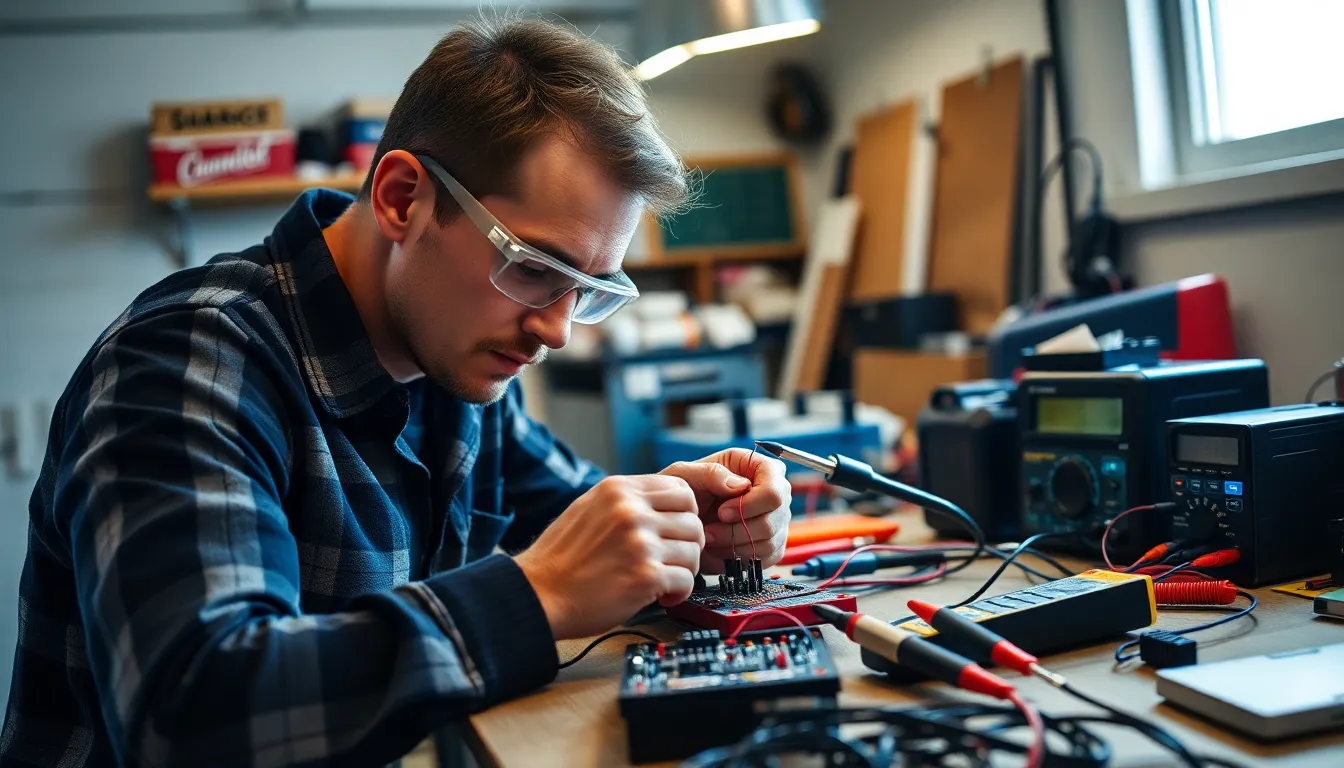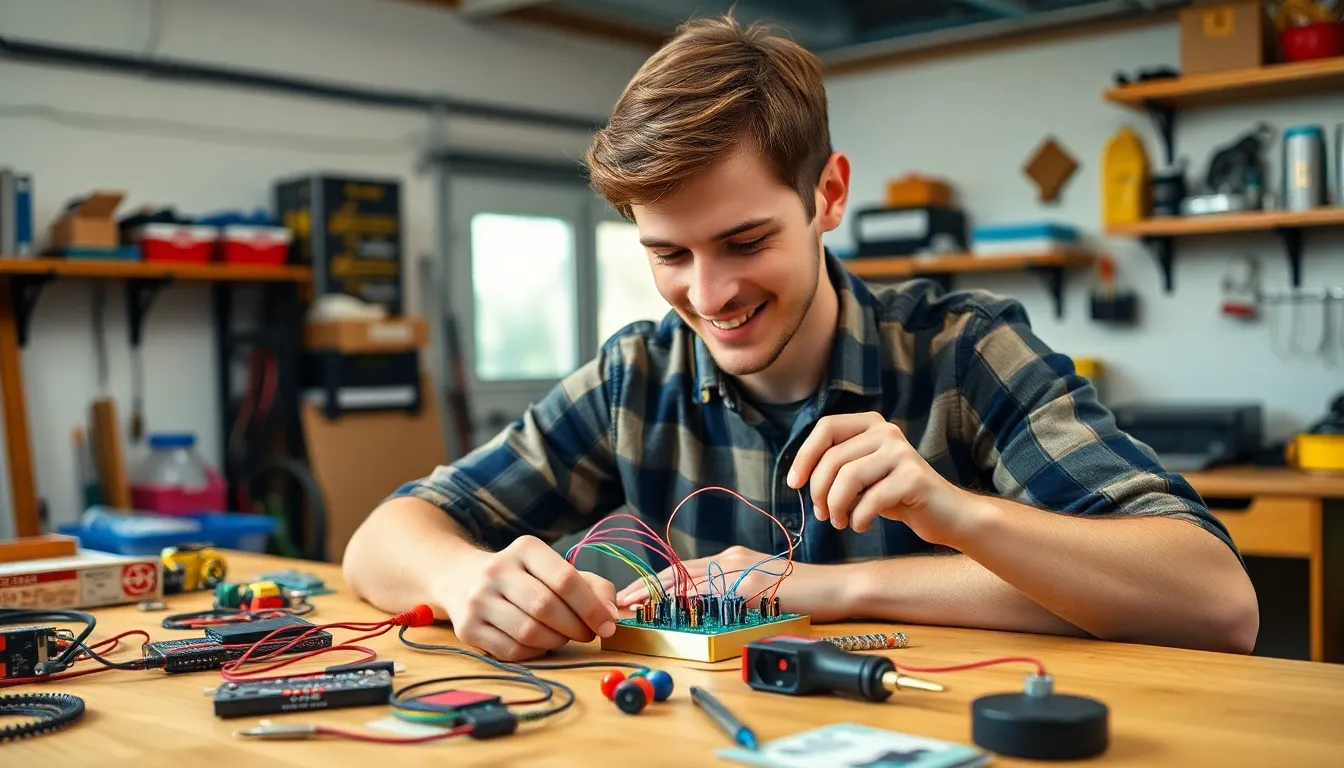Dive into the electrifying world of DIY electronics projects, where creativity meets circuitry and sparks fly—literally! Whether you’re a seasoned tech wizard or a curious newbie, there’s something utterly satisfying about crafting your own gadgets. Forget about those overpriced store-bought devices; with a little ingenuity and a handful of components, anyone can become a modern-day inventor.
Table of Contents
ToggleOverview of DIY Electronics Projects
DIY electronics projects encompass a wide range of creative endeavors using electronic components. These projects allow individuals to construct gadgets that serve personal purposes, often leading to a better understanding of technology. Crafting unique devices empowers people to customize their electronics based on specific needs or interests.
Beginners often gravitate toward simple projects like LED blinkers or basic sensors, which introduce fundamental concepts. As skills develop, they can tackle more complex systems such as microcontroller-based designs or automated home solutions. Experienced enthusiasts frequently experiment with robotics, audio equipment, or even wearable technology, expanding their knowledge and expertise.
Many resources are available for those wanting to dive into this craft. Online platforms provide tutorials, schematics, and forums where DIYers can share ideas and seek guidance. Community makerspaces offer hands-on experience, featuring tools and materials for independent projects or collaborative efforts.
Toolkits essential for DIY electronics include soldering irons, multimeters, and various hand tools. Quality components such as resistors, capacitors, and microcontrollers serve as the foundation for countless projects. Selecting the right materials often determines project success, impacting both performance and durability.
Engaging in DIY electronics projects invites creativity, problem-solving, and technical growth. They foster a sense of achievement while allowing individuals to explore new ideas and capabilities. Through community involvement and active learning, enthusiasts contribute to a vibrant technological landscape.
Getting Started with DIY Electronics

Exploring DIY electronics projects begins with understanding essential tools and materials. Proper equipment and components streamline the process and enhance the overall experience.
Essential Tools and Materials
Soldering irons serve as a fundamental tool for connecting components. Multimeters measure voltage, current, and resistance, ensuring that projects run smoothly. Breadboards allow for temporary circuit setups without soldering, making them ideal for beginners. Jumper wires provide crucial connections between components, enabling prototypes to come together. Quality components like resistors, capacitors, and diodes play vital roles in circuit functionality. Beginners often benefit from starter kits that include these essentials, along with detailed instructions.
Safety Precautions
Safety must remain a top priority during electronics projects. Wearing safety glasses protects eyes from solder splashes and accidental component burnouts. Handling components carefully prevents damage along with personal injury. Working in well-ventilated areas ensures that fumes from solder or other materials disperse promptly. Keeping a fire extinguisher nearby reinforces caution when using soldering tools. Avoiding prolonged exposure to soldering fumes promotes a healthier workspace. Properly storing all components and tools helps prevent hazards and ensures an organized working environment.
Popular DIY Electronics Projects
DIY electronics projects offer various challenges for different skill levels. These projects range from simple beginner kits to complex systems that demand advanced techniques and knowledge.
Beginner-Friendly Projects
Simple projects invite newcomers to explore the world of electronics. Examples include LED blinkers, which require basic components like a battery, LED, and resistor. Building a simple circuit with these items helps individuals learn about current flow and circuit design. Another great choice is a basic light sensor that activates an LED based on ambient light levels. Beginners often find these early projects both fulfilling and educational, establishing a foundation for more complex endeavors.
Intermediate Projects
Intermediate projects present additional challenges while fostering creativity. DIY clock circuits utilize a 555 timer chip, allowing builders to understand timer functionalities and oscillator circuits. Another popular project involves creating a simple Arduino-based weather station, which incorporates sensors to measure temperature and humidity. Engaging in these projects enhances problem-solving skills and establishes a deeper understanding of microcontrollers and sensors.
Advanced Projects
Advanced projects push the boundaries of innovation and require significant technical knowledge. Robotics enthusiasts may build autonomous robots equipped with sensors for navigation. These intricate systems often involve programming languages like Python or C++. Another sophisticated option includes designing a home automation system using IoT devices, which enables control of appliances through smartphones. Tackling these advanced projects boosts proficiency, fosters creativity, and opens doors to professional opportunities in electronics engineering.
Tips for Successful DIY Electronics Projects
Successful DIY electronics projects require careful planning and execution. Adopting a methodical approach can help avoid common pitfalls.
Troubleshooting Common Issues
Common issues often arise during DIY electronics projects. Checking connections and ensuring everything is secure typically solves many problems. It’s essential to inspect solder joints for cold solder connections or mistakes. If a circuit doesn’t work, testing components with a multimeter can identify faulty parts. Changing one variable at a time helps isolate the issue, making troubleshooting more effective. Beginners frequently encounter problems with non-functioning components; understanding datasheets provides clarity on specifications and limits. Maintaining patience allows for a more thorough debugging process.
Resources for Learning and Inspiration
Numerous resources aid in learning and gaining inspiration for DIY electronics projects. Online platforms like Instructables and Adafruit offer extensive tutorials designed for different skill levels. YouTube channels such as EEVblog and GreatScott! provide visual breakdowns that simplify complex concepts. Community forums and makerspaces allow for collaboration and sharing of ideas. Books on electronics also serve as valuable references, covering foundational theories and innovative techniques. Attending local workshops fosters connections and enhances skills through hands-on experiences. Engaging with these resources not only builds knowledge but also sparks creativity.
Embarking on DIY electronics projects opens up a world of creativity and innovation. Whether someone is a beginner or an experienced maker there’s immense satisfaction in crafting personalized gadgets. The journey not only enhances technical skills but also fosters problem-solving abilities and creative thinking.
With the right tools and resources anyone can dive into this rewarding hobby. From simple LED projects to complex robotics there’s always a new challenge to tackle. The DIY electronics community offers a wealth of support and inspiration, making it easier than ever to start building and inventing. Embracing this hands-on approach can lead to exciting discoveries and even pave the way for future career opportunities in technology.



